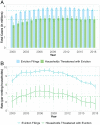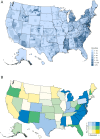Estimating eviction prevalence across the United States
- PMID: 35576463
- PMCID: PMC9173767
- DOI: 10.1073/pnas.2116169119
Estimating eviction prevalence across the United States
Abstract
SignificanceSeveral negative effects of forced displacement have been well documented, yet we lack reliable measurement of eviction risk in the national perspective. This prevents accurate estimations of the scope and geography of the problem as well as evaluations of policies to reduce housing loss. We construct a nationwide database of eviction filings in the United States. Doing so reveals that 2.7 million households, on average, are threatened with eviction each year; that the highest eviction filing rates are not concentrated solely in high-cost urban areas; and that state-level housing policies are strongly associated with county-level eviction filing risk. These data facilitate an expanded research agenda on the causes and consequences of eviction lawsuits in the United States.
Keywords: eviction; housing policy; residential inequality.
Conflict of interest statement
The authors declare no competing interest.
Figures




References
-
- Hartman C., Robinson D., Evictions: The hidden housing problem. Hous. Policy Debate 14, 461–501 (2003).
-
- Greenberg D., Gershenson C., Desmond M., Discrimination in evictions: Empirical evidence and legal challenges. Harv. C.R.-C.L. L. Rev. 51, 115–158 (2016).
-
- Weitzman B. C., Knickman J. R., Shinn M., Pathways to homelessness among New York City families. J. Soc. Issues 46, 125–140 (1990).
-
- Desmond M., Kimbro R. T., Eviction’s fallout: Housing, hardship, and health. Soc. Forces 94, 295–324 (2015).
Publication types
Grants and funding
LinkOut - more resources
Full Text Sources

